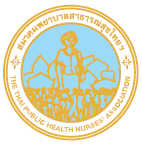Factors Related to Yellow Fever Prevention Behaviors of Thai Travelers Travelling from Yellow Fever Infected Areas
Keywords:
Yellow Fever, Precede Framework, Thai Travelers, Preventive behaviorsAbstract
Nowaday, yellow fever is a significant public health issue. According to the World Health Organization, yellow fever outbreaks are mostly caused by travelers who have not been immunized with the yellow fever vaccine and have poor self-care during their journey. The objective of this research was to investigate the predictive factors including predisposing, enabling, and reinforcing factors on yellow fever preventive behaviors of Thai people based on the PRECEDE Framework. The sample consisted of 395 people. Data were collected using a good reliability questionnaire with Cronbach's alpha coefficient more than 0.70 in all parts of the instrument. Data were analyzed using descriptive statistics and stepwise multiple regression analysis.
The results showed that enabling factors i.e., access to travel medicine services and perceived laws and regulations related to yellow fever prevention; reinforcing factors i.e., received recommendation and information from public health officers; and predisposing factor which was purposes of travel could explain the variation of yellow fever preventive behaviors by 20.2%.
The findings from this study could be used as an evidence for relevant agencies to promote yellow fever preventive behaviors for Thai travelers by emphasising on facilitating the access to travel medicine services. This could be the mean to provide travelers with knowledge about yellow fever and correct self-care practices during the journey.
References
Piyaphanee W. Travel Medicine and Tourism. Bangkok: Natikul Printing; 2018. p. 49-58.
Division of Communicable Diseases. Important vectors and disease vector control program in the entrance and exit channels. Bangkok: The Agricultural Co-operative Federation of Thailand Press; 2008; p. 73-6.
Monath TP, Cetron MS. Prevention of yellow fever in persons traveling to the tropics. Clin Infect Dis. 2002; 34(1): 1369-78.
Center of Diseases Prevention and Control. Health Information for International Travel 2016 [Internet]. 2016 [cited 2020 February 20]. Available from: http://www.cdc.gov/travel/page/yellowbook-home.
Division of Ineternal Disease Control Ports and Quarantine. Report on screening results of travelers from areas where dangerous communicable diseases are endemic. internationalquarantine checkpoint in Suvarnabhumi airport; 2019.
Lourenco J, Recker M. The 2012 Madeira dengue outbreak: epidemiological determinants and future epidemic potential. PLOS Negl Trop Dis 2012; 8(8): e3083
World Health Organization. Dengue: Guidelines for Diagnosis, Treatment, Prevention and Control. France: WHO; 2009.
Nomsiri A, Phongphaitoonsin N. Relationships between Individual Factors and health preparation of independent travelers prior to travel abroad. TMJ 2019; 19(1): 152-63. (in Thai)
Uthayan C. Tourist Behaviour [Internet]. 2009 [cited 2020 February 28]. Available from: https://touristbehaviour.wordpress.com/1/
Green LW, Kreuter MW. Health program planning an educational and ecological approach. New York: Quebecor World Fairfield; 2005.
Daniel WW. Biostatistics: A foundation for analysis in the health sciences. New York: Wiley & Sons; 1995.
Heywood AE, Zhang M, MacIntyre CR, Seale H. Travelrisk behaviours and uptake of pre-travel health preventions by university students in Australia. BMC Infect Dis 2012; 12(1): 1-9.
Jirachetpattana C. Haemorrhagic fever prevention and controlling behaviors of people in Sop Prap Tambon Municipality, Sop Prap District, Lampang Province [Master’s thesis in Community Nurse Practitioner]. Chiang Mai: Chiang Mai University; 2008.
Green LW, Kreuter MW. Health program planning an educational and ecological approach. New York: Quebecor World Fairfield; 2005.
Meekhun R, Saliach K, Songsri C. Factors associated with the prevention and control behavior of dengue hemorrhagic fever among BAN NONG I BAO people, Khon Yung Subdistrict, Kut chap District, Udon Thani. Nursing, Health, and Education Journal 2019; 2(2): 26-34. (in Thai)
Trade A. Thailand's tourism crisis due to the COVID-19 outbreak [Internet]. 2020 [cited 2020 October 12]. Available from: https://accesstrade.in.th/Thailand'stourismcrisis/
Compass K. Penetrating travel behavior in the New Normal: when covid changes lives [Internet]. 2020 [cited 2020 October 12]. Available from: https://rb.gy/evwy5q.
ICAO. Effects of Novel Coronavirus (COVID‐19) on Civil Aviation: Economic Impact Analysis [Internet]. 2020 [cited 2020 October 12]. Available from: https://www.icao.int/sustainability/Documents/COVID-19/ICAO_Coronavirus_Econ_Impact.pdf
Downloads
Published
How to Cite
Issue
Section
License
บทความที่ตีพิมพ์และแผนภูมิรูปภาพถือเป็นลิขสิทธิ์ของวารสารพยาบาลสาธารณสุข (Thai Public Health Nurses Association)







